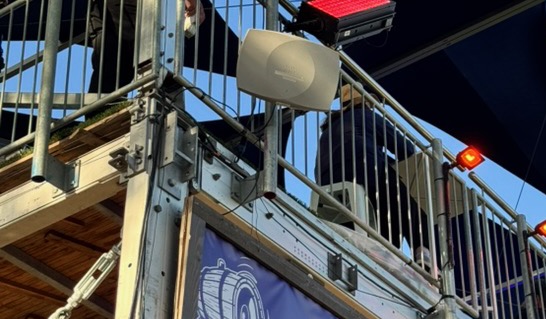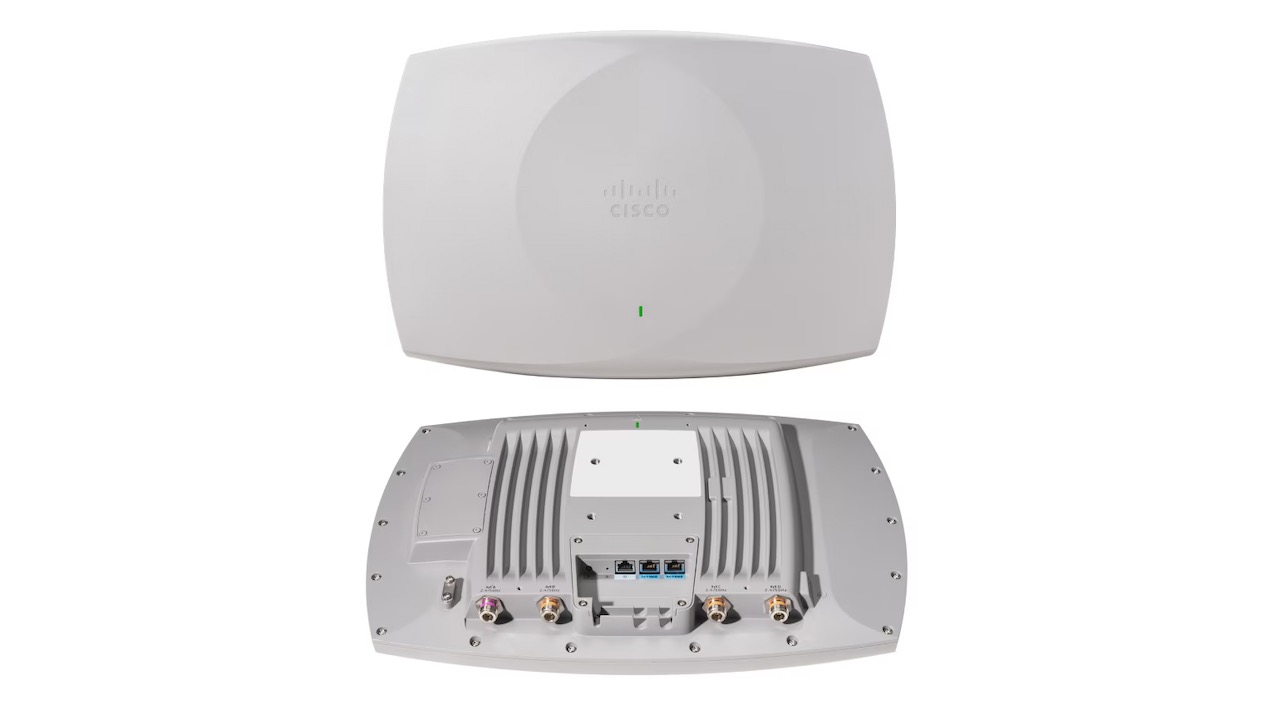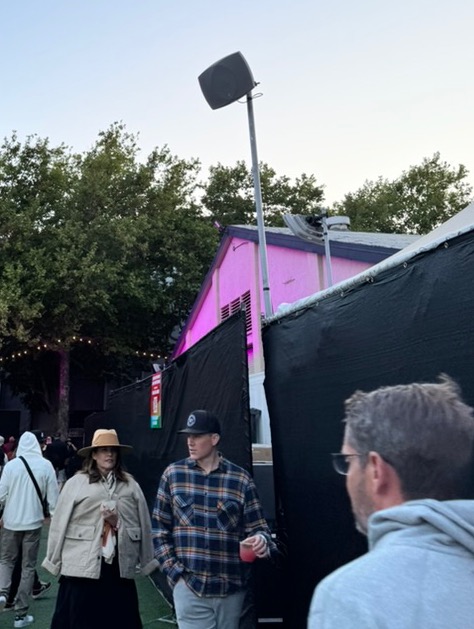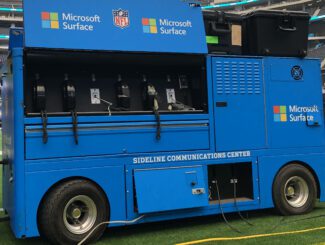
Cisco is doubling down on its recent antenna innovations by expanding the capability of its ‘Marlin’ 9104 hyper-directional stadium antenna, with a new version that adds support for Wi-Fi 7, some extra radios and the ability to easily switch between indoor and outdoor modes.
The new CW9179F, announced June 10 at the Cisco Live conference in San Diego, sports a new code name “DB10,” after the James Bond model of an Aston Martin. As Cisco moves its antenna code names from fish to fast cars the new device is smaller, lighter and has more powerful Wi-Fi radios than its saltwater-themed predecessor, including support for the 6 GHz band used by the Wi-Fi 7 standard.
“We took everything we learned in developing the Marlin, and improved it,” said Matt Swartz, a Cisco Distinguished Engineer and thought leader behind the 9104. The new version, he said, “exceeds performance of the older one in every category.”
Taking a good idea and improving it
If you’re not familiar with the Cisco Marlin (9104 in official Cisco branding) antenna — the first hyper-directional product from the longtime networking giant that appeared in 2021 — then you probably aren’t responsible for the building and operation of Wi-Fi networks inside stadiums. (For more in-depth reporting and analysis on hyper-directional antennas, please see our recent Market Report on the subject.)
Custom designed for stadium deployments, the original 9104 put Cisco’s manufacturing, sales and support weight behind the somewhat radical idea of a Wi-Fi antenna that could reach up to 200 feet between antenna and client, almost three times the range of a traditional stadium Wi-Fi antenna.

Though it wasn’t the first such product in the category — that honor belongs to a company called Everest Networks, which developed and released its own version of a hyper-directional Wi-Fi antenna in 2017 — it’s hard to argue with Swartz’s opinion that “we saw what they [Everest] did, and went and built something better.”
So what did Cisco do for its second act in the hyper-directional antenna market? According to Swartz, the company looked to improve from the original 9104 in as many ways possible, with feedback from customers providing direction on what features to add and in some cases, what to leave out.
Though the spectrum wasn’t yet approved when the Cisco team started designing the new CW9179F, it has a 6 GHz radio that gives it access to the 1,200 MHz of new unlicensed spectrum in that band. By being compliant with the new Wi-Fi 7 standard the antenna also supports both indoor and outdoor use under the Wi-Fi 6E FCC rules.
According to Swartz, the CW9179F starts out as an indoor unit but can be easily converted to an outdoor unit via a snap-in “door” on the back of the device that includes all the necessary chips and communication needed for the automatic frequency coordination (AFC) required for outdoor 6 GHz use. The door itself will be called an “environment pack” and it converts the AP from a low power indoor device to a standard power only device. The accessory comes with all the necessary parts to weatherize the unit, according to Cisco.

In addition to the new 6 GHz radio, the CW9179F includes Wi-Fi 7 compatible 5 GHz radios and a 2.4 GHz radio, along with another radio for IoT. It also adds is the ability to reconfigure some of the radios to aim coverage out the back of the antenna, to cover seating areas directly behind the device. According to Swartz there are four N connectors on the unit that can be used to switch one of the 5 GHz radios and the 2.4 GHz radio to and augment coverage behind the AP.
“When you deploy on an overhang, you often get a hole of coverage left behind you,” Swartz said. Adding small antennas (which got their own code name, “Sardine”) allows venues to cover the much-closer top-row seats from the back of the CW9179F unit instead of having to install a completely separate device.
The CW9179F is also smaller (18.7 inches by 13 inches) than the original 9104’s 23.5-inch by 18.5-inch span, and weighs 10 pounds, almost 6 pounds less than the original. The CW9179F also has a simplified set of configuration options, which Swartz said will help increase the performance of the device.
Wi-Fi 7: Fast On, Fast Off
One thing Swartz doesn’t want to get caught up in is predicting how many client devices a CW9179F could support. “I’m more about ‘how many RF cells can I cram in,’ ” Swartz said. “How can I get it to operate efficiently as possible and not have the cells beat each other up.”

What Swartz is excited about is the performance leaps that should come when the devices start using the new wide-open spaces of the 6 GHz bandwidth, which will allow for much larger communication channels, with 80 Mhz channels becoming normal.
“My term for it is FOFO — fast on, fast off,” said Swartz. “If you have a wider channel, you can serve clients faster. Now when someone wants to download a photo, it happens instantly, and they’re gone, so the antenna can serve another client. People are going to be impressed.”
Increasing the performance and ROI for hyper-directional technology
With the CW9179F offering, Cisco has extended its competitive lead in the market for what we call “hyper-directional” antennas, devices that support long-reach communication from antenna to customer device and the ability to fine-tune their communication beams. Right now, none of the top competitors in the stadium Wi-Fi space even have a first-generation hyper-directional antenna publicly available. (For more in-depth reporting and analysis on hyper-directional antennas, please see our recent Market Report on the subject.)
Everest Networks, the only other provider with a historical part in the hyper-directional stadium Wi-Fi market, was recently purchased by security specialist Fortinet. Though Fortinet made some casual claims about plans for building a Wi-Fi 7 version of the Everest product, the company has not announced any precise product plans. Other stadium Wi-Fi gear suppliers have said they expect to have a hyper-directional product available in “the second half of calendar 2025,” but like Fortinet, no specific product plans or availability timing have been announced.

How do hyper-directional antennas work? Hyper-directional antennas came about when people found different ways to “focus” a wireless signal from an antenna, instead of spreading it around in many directions.
On the Wi-Fi side, some innovative work with radio frequency (RF) filtering allowed two companies, Everest and Cisco, to develop products that had operable ranges of about three times the reach of a regular stadium Wi-Fi antenna. For Cisco, the filtering in its hyper-directional products “acts like earmuffs” on the antenna, limiting the so-called “east to west traffic,” according to Swartz. By limiting the side lobe contention, the hyper-directional Wi-Fi antennas can increase their power to the directed signals, allowing for the greater communication reach.
Tuning and deploying hyper-directional antennas is also generally easier than other stadium network strategies, and ceiling-mounted hyper-directional antennas can provide coverage where other methods can’t reach, such as the playing field or stadium floor. (For more in-depth reporting and analysis on hyper-directional antennas, please see our recent Market Report on the subject.)






